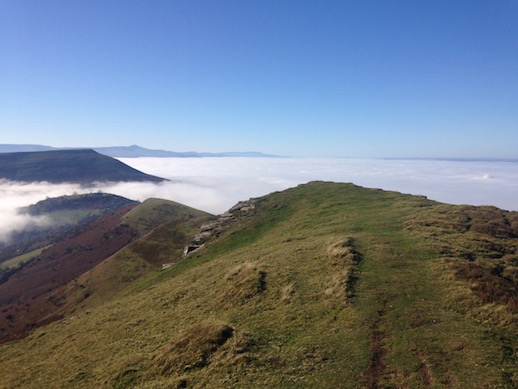It was strange how fast November happened. On Halloween we climbed the Dragon’s Back, a ridge at the western edge of the Black Mountains near where I live in Mid Wales, and the kids basked in the sun on the rocks by the cairn, stripped down to vests, and refused to come back down until it was nearly dark.
The month announced itself in style: we spent its first day driving through Herefordshire in a thick fog that picked out every cobweb and leaf edge. On the second, sick of all the gloom, I climbed the Dragon’s Back again, and halfway up found myself in the same warm sunshine as two days previously. There was a thin black line marking the top of the Begwns and the Radnor hills to the north; to the west, the peak of Pen-y-Fan pointed out of the murk; closer by, I could see Mynydd Troed and the hills beyond the pass marked out against the contours of cloud poured into the valleys.
The fog stayed all week until the rain set in. By the weekend, we were huddled by the fire although it was still warm: it is strange how psychological the cold is. With a couple of hours of light left, I insisted on a walk.
There’s a circular walk that I have started to default to when I need to get out, which always starts at Pwll-y-Wrach, the Witches’ Pool, a wooded waterfall that descends the hill behind Talgarth, and ends at the abandoned psychiatric hospital nearby, a strange and haunting place that once formed much of the town’s character and employment. The woods were carpeted with leaves, which was a good thing because it is the most relentlessly muddy place I know, and we were not wearing sensible shoes.
By the time we got to the waterfall I’d given up on fighting the mud. It was everywhere. I don’t know what prompted me to suggest getting in, but I was with a Swede and he took it seriously, and pride demanded that I follow through too. I’d started running on the Begwns with a gang led by a Norwegian who was forceful on the benefits of a cold-water dip in the pond at the end, which made me shriek and made passers-by howl with laughter, but the Scandinavian mindset that engaging with cold is the best strategy for dealing with the winter months was starting to make sense.
We slid down the muddy bank, looking for the bits with the most fresh leaves for ballast, and stripped off on a rocky ledge. The air was warm and the water surprisingly tolerable. The bifurcated streams of the waterfall, separated by a big central pillar of red rock, threw cold spray at our heads, so that you might as well get in. The pool – I assume that it is this pool, anyway – was supposedly used for dunking suspected witches in order to determine whether they were guilty or innocent. We were undrowned and unrepentant. Someone came up the path and we dressed in a hurry.
It is the bit beyond the big waterfall that I like the best: the river meanders down smaller rocks and pools and the wood is beautiful and unmarked by observation platforms and tourist trails. From there we scrambled up to the old drover track to the common, where yet another waterfall roared on the downhill side, and crossed a stream that was suddenly less fordable than it had been a week ago.
I’d been extolling the virtues of Welsh weather earlier in an attempt to leave the house: the rain meant waterfalls and rainbows were ten a penny, like the thick mossy banks in the woods. Now, a rainbow emerged, spanning the common in a full bright arc from the mountain escarpment all the way back to Talgarth, as though to illustrate the point.
We ran back down the hill, pocketing handfuls of the last sloes on the hedgerow. A farmer was training a new sheepdog in the field on the left, who circled the docile ewes to whistled signals in perfect submission. On the right was a weird-looking creature with a pitbull face and an S&M-style harness and improbably vast balls, which we eventually concluded was a tup. He caught us staring and looked over, as though to see if we wanted to start a fight, and then got on his knees and ate some grass, bored.
The old hospital had a new swathe of police tape over the front door. I wanted to go in and see which parts had been freshly torn down by waves of weather or human malfeasance, but the cold-water fearlessness had worn off, and it was already getting dark, and we went home for tea.
Nina’s book, Uprooted: on the trail of the Green Man, is due to be published by Faber in March 2016.
